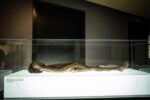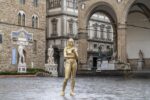Helena Hladilova – Hafgufa
.jpg)
Mostra personale.
Comunicato stampa
"There is a fish that I have not mentioned yet, about which it is good to avoid talking about its size, as it would seem unbelievable to most people. There are very few who can speak clearly about it, for it rarely comes close to land or appears where it might be seen by fishermen, and I suppose there are not many fishes of this species in the sea. Often in our language, we call it hafgufa. Nor can I speak with certainty of its size in aune1 because the times it has shown itself to men it has appeared more like land than fish. Nor have I heard that one has ever been caught, or found dead; and I believe that there should not be more than two in the oceans, and that each one is incapable of reproducing, for I believe they are always the same. It is said that it is the nature of this fish that when it wants to eat, then it extends its neck with a great belching, and throws out so much food that all kinds of fish that are nearby flock to the place; but this great fish leaves its mouth open in the meantime, and the opening is no less wide than that of a great fjord, and the fish cannot avoid flocking there in great numbers. But as its stomach and mouth are full, then it closes its jaws together and catches and imprisons all those fish, which had so greedily come there in search of food."
[Konungs skuggsjá (Norse: "mirror of the king") is a Norwegian didactic text composed around 1250 and designed for the education of the sons of King Haakon the Elder, Magnus Lagabøter and Haakon the Younger (although the text is addressed to all members of the court). Its author, probably a clergyman in the king's court, has remained anonymous].
Dialogue:
H. when I started imagining the exhibition for Flip and Naples I immediately thought of the image of the octopus.
Don't be offended, when I think of Naples, I always imagine it from a distance, from some distance; I think of the sea and its aerial image.
F. No, absolutely, no offense, I imagine Naples in the same way. There are architectural points of interest and a timeless charm; of course living in the city is extremely tiring/demanding/exhausting/strenuous, one is thus pushed to leave it for a while – but the moment I look at it from a distance I understand another way of experiencing and admiring it when my slight is about to land. Then I am breathless; or, when at 7am I leave the Campi Flegrei in an inflatable dinghy, I observe it from afar, the city finally silent, I float on a sea smooth as glass.
H. The octopus is almost like my pet, intelligent, 'cool', if you cut off a tentacle it grows back, like a mutant.
F. Well if we want to put metaphorically, Naples is both a morphological-geological mutant, we live in a complex volcanic web intertwined, and then there is also its daily frenetic structure, the Neapolitan adapts, invents, transforms to it.
Flip Project is pleased to announce the first show in Naples of Helena Hladilova in its new space in the heart of the city.
Flip’s new location is located in the courtyard of a building in Via Giovanni Paladino near Piazzetta Nilo, in a 1950s noble chapel, recovered after a long period of neglect.
Hladilova has created a series of new works all related to the iconography of the octopus. They are mainly bas-reliefs in polychrome marble, with watercolor glazes of color, often with inserts of bronze castings.
For some years now, Helena has been making a series of works on fairy imagery, dreamlike, mythological figures, monsters, but also mutant beings, hybrid creatures; passing between fantasy, myth, and reality: a way of imagining and thinking about new conditions or possibilities experienced in everyday life.
Influenced by her two children, she recently saw herself catapulted into fairy-tale readings, into a fantasy universe, parallel to that of adults and especially to the imagery related to Norse mythology (Nordic-Scandinavian mythology).
1 The auna is an ancient unit of measurement in use in some countries in northern Europe (particularly France and Flanders) before the introduction of the metric system.



